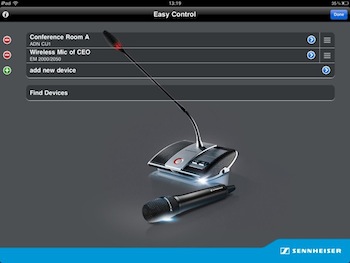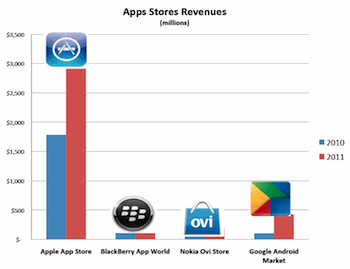Despite the Stanley Kubrick vision of HAL 9000 making its own decisions and telling Dave what he can and cannot do in 2001: A Space Odyssey, computers really won’t do anything without instructions. These are provided by software applications, which have been around as long as computers themselves. Today, of course, we call these “apps”, and one exists for nearly everything you want your mobile device to do. For any apps that don’t exist, there are armies of independent developers eager to create one for you. What’s more amazing than the sheer volume of apps available today is how quickly they’ve exploded into the mainstream.
- The keen marketers at Apple probably facilitated the popular abbreviation of the term “applications” to “apps” because of the subliminal connotation to its brand. Although today there are far more apps for Apple products than any other mobile device, they certainly did not invent the category. The first mobile apps were part of the Windows CE 3.0 operating system (later called Windows Mobile), and there were more than 20,000 apps available before the Apple App Store was launched in 2008. Early apps were general business tools including mobile versions of Microsoft Office for the Pocket PC. Today, that’s all changed.
- App Explosion
- The first catalyst for the recent proliferation of apps was the launch of the Apple iPhone in January 2007. Although the first iPhones could not natively install third-party applications, they quickly resolved that limitation and announced a few months later in June 2007 that the iPhone would support third-party "web 2.0 applications." The following year, Apple introduced the second-generation iPhone, and more importantly, the App Store, which, for the first time, allowed online distribution of third-party applications for the iPhone platform. Almost overnight, there were over 20,000 apps (including games) available for the iPhone. The second catalyst occurred in January 2010, when the Apple announced the iPad. App developers could immediately envision the impact this larger touchscreen device could have on the apps market, and that’s when the so-called “Apps Explosion” really took hold. The number of Apps in the iTunes Apps store nearly doubled—before the first iPad even shipped six months later. The beauty of the Apple App store was that it vastly simplified the experience of installing applications on your mobile device and made in inexpensive too—in many cases, free.
Tracking the statistics in the world of apps is tricky business. For one thing, there is a high “churn” rate; according to some sources, as many as 26 percent of apps downloaded are used only once, and never updated. On the other hand, equal percentages have become loyal customers (according to Localytics, March 2011). Another issue is that things are changing rapidly. Although 2010 revenue figures from apps indicated an Apple advantage of a factor of almost ten, in 2011, Google made strong progress, quadrupling its apps revenues. According to analyst firm IHS iSuppli, in 2011 the Apple App Store accounted for about 75 percent of the apps market at about $2.91 billion, but this share will drop to 60 percent by 2014. And in 2011, Google’s Android Market soared past Blackberry to just under a half-billion dollars, making it the second largest app store.
It’s also important to consider the types of apps that account for these figures. IHS iSuppli says that in the U.S., games accounted for over 72 percent of top grossing iPhone applications and more than 60 percent of top grossing Android apps during the third quarter of 2011. Apps that have any relevance to the work applications for technology managers are a tiny sliver of the nearly one billion apps available among all apps stores.
What Tech Managers are Using
Despite the relatively small percentage of apps for AV and IT technology managers, there’s no doubt that mobile apps have literally changed the way they work. The use of mobile devices to support systems and devices across large campuses has liberated technicians, and saves time and money too. Help desks are no longer office-bound. Technicians can access and troubleshoot an AV system from anywhere. And delicate test and measurement equipment, which once required roadcases and dollies to transport from one building to the next, can be easily and cheaply accessed from a wide range of hand-held mobile devices.
“We currently have Extron Global Viewer Enterprise installed on a virtual server on campus,” said Dan Huber, senior IT/AV technician at Gannon University in Erie, PA. “This allows me to make use of their iGVE app for iOS devices. I’ve used it both on my iPhone and iPad.”
Used with Global Viewer Enterprise, iGVE allows users to effectively manage and control large-scale AV installations from a mobile device. This allows technicians like Huber to provide quicker and more reliable support. “I get emails about disconnected projectors/lamp failures, or when lamps need replacing. Basically, I can predict problems before they happen. And in addition to the monitoring function, iGVE allows remote control of devices, so I can control anything connected to the Extron MediaLink Controller in the lecterns, all remotely.”
Besides control and monitoring, there are hundreds of apps for audio and video testing, measurement, and set-up. Like most apps, the prices range from free to as much as 20 dollars—a far cry from hardware-based real time analyzers, oscilloscopes, signal generators that once cost hundreds (if not thousands) of dollars. Tech managers and rental/staging engineers have found these tools to be invaluable on the job.
“On my iPad, I use AudioTools, which gives me an SPL meter, real time analyzer, signal generator, and many more features,” reported Travis Mathna, who provides audiovisual integration services and support at Gettysburg College in Pennsylvania. AudioTools was developed by Studio Six Digital, which offers a whole range of iOS based apps for audio professionals. Last year, they began offering Smaart Tools, developed in conjunction with Rational Acoustics (makers of Smaart Acoustic Test and Measurement software). Smaart Tools is a single channel module available as an “In-App” purchase within Studio Six Digital’s AudioTools.

One of the great promises of any technology has been carbon footprint reduction and minimizing the waste of natural resources. The “paperless office” and “green meetings” are common sustainability goals of many organizations. One area of incredible paper waste is the printing of event guides, which usually have a shelf life that expires when the event is over. To make matters worse, meetings, trade shows, and other events often print thousands of event books that number in the hundreds of pages. One company that is trying to make a difference through apps is Quickmobile. The Vancouver, BC-based company offers a wide range of services and solutions for mobile users, including custom apps for events. One of their customers is Liberty Mutual, the Boston-based Fortune 100 company. Brian Halderman is the director of production and event technology for the company, and he says the apps that Quickmobile develops for them is a vast improvement over printed books. “We have been creating event specific mobile apps for attendees of our largest events that provide schedules, maps, speaker bios, activity descriptions, in-app video distribution, and in-app messaging—everything you get with a printed event guide, plus a whole lot of interactive tools that would otherwise be impossible,” says Halderman.Apps in the Future
When industry observers look back on the first decade of the 21st century, it’s a safe bet that the sudden appearance and proliferation of mobile devices will be seen as a disruptive technology on the scale of Edison’s light bulb and the PC. Within just a few years, adoption has grown from tens of thousands to billions. Analysts at Morgan Stanley have predicted that by 2020 there will be 10 billion mobile internet devices in use, up from about 2 billion today. It’s no surprise that users expect that their smartphones and tablets should be capable of doing just about anything they need to do, both for entertainment and professional applications. Multiple purpose mobile devices have become the hardware interface of choice for just about everything, especially in the world of AV technology. And as the number of mobile apps continue to multiply at exponential rates, the impact on the world of technology users is likely to be pervasive. For vendors, this has strategic implications, since it means less demand for and reliance on black-box solutions and more attention to software development. For AV technology managers, it means accomplishing more with few devices in less time—which, after all, should be the goal of any technology.
Mark Mayfield is an independent consultant, analyst, and writer in the communications technology industries. He can be reached at mmayf56@hotmail.com.
